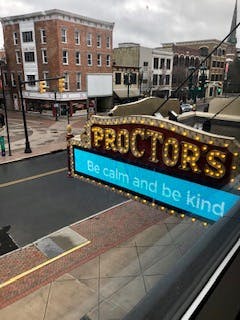Taking Deep Breaths While Slowly Deploying a Community Microgrid in Schenectady, N.Y.
For Philip Morris — who has been shepherding a community microgrid in Schenectady, N.Y. toward completion for nearly 15 years — taking deep breaths has been the go-to for moving the project forward.
“Be patient. Everyone has to be a partner or it will never happen,” said the CEO of Proctors Collaborative, a consortium of businesses and nonprofits that includes Proctors Theatre, Capital Repertory Theatre and Universal Preservation Hall, as well as subsidiary Marquee Power.
The non-profit organization is finally moving closer to deploying a 600-kW community microgrid that will serve Proctors Theatre and about 17 businesses in downtown Schnectady’s Center City. They include a YMCA, bank, restaurant, engineering offices, the campus of a community college, and an insurance company office, encompassing 180,000 square feet and 17 customers. The microgrid will mostly be off-grid, with power from utility National Grid as occasional backup.
Bidding for a construction contractor will begin soon, and construction is expected to start this summer. Ameresco is providing the microgrid.
Morris’ journey began around 2005, when the theater decided that in order to produce Broadway-style plays, it needed to revamp the buildings, and along the way, the “dilapidated” downtown’s method of delivering heat and air conditioning.
At the time, the city, which once had 40,000 General Electric employees, was just a remnant of being a company town, said Morris. Many of the buildings in the downtown block around the theater were closed. Part of his job was to renovate some of those buildings, but he also decided to focus on energy — in part because he had experience as a board member of a utility in Jamestown, N.Y.
“We took the gamble of not just designing a thermal system and starting a collaborative for ourselves, but for others,” he said. This made sense because most of the building systems needed to be replaced.
In 2005, Marquis Power, which acts like a small electric cooperative, began producing hot and cold water underground to provide central heating and air conditioning for customers. The non-profit also began offering to melt snow in the downtown area. It began with one customer, then quickly added more.
The hope for the snow melting was to ensure residents wouldn’t view snow as an impediment to going to the theater.
The New York State Energy Research and Development Authority (NYSERDA) provided Marquis Power with funding to look into installing a cogeneration-based microgrid. The non-profit purchased and installed four 60-kW microturbines and a chiller to capture waste heat.
Interested in microgrids? Join us in Anaheim, California May 16-17 for Microgrid 2023: Lights On!, an annual gathering for the microgrid industry and those exploring microgrids for their facilities.
But the company never hit the switch on the microturbines, and eventually donated them to a developer in nearby Albany, N.Y. Utility National Grid changed the rules about how and when independent power producers could feed power to the utility, and that put the kibosh on the microgrid, said Morris.
Then, in 2011, Hurricane Irene hit the region, along with Tropical Storm Lee, and Schenectedy’s downtown flooded. Electrical outages lasted for up to a week in some places.
After the storms, the Proctors microgrid project was one of the winners in the New York State Homes and Community Renewal’s NY Prize Microgrid Competition, an effort that challenged communities, businesses and utilities to design and implement community microgrids that offer energy independence and local power generation and distribution. It was selected due to Schenectady's vulnerability to flooding and power outages.
The New York State Homes and Community Renewal program will fund the project, whose cost was recently increased to $8.5 million. The microgrid was originally estimated at $7 million, but COVID slowed down the project, said Morris.
"This project is part of the next generation of microgrids that are designed to both repair energy systems damaged from recent storms, while also strengthening New York's resiliency. We are thrilled to help harden a local grid with a resilient power supply for the Proctors Theater and surrounding community,” said Shachar Roloson, a spokesperson for the New York State Homes and Community Renewal program.
The microgrid is expected to meet the needs of its customers — who have a peak load of about 550 kW — for all but five to 25 days a year. The highest load, about 750 kW, occurs when the theater is staging productions, said Morris. The customers’ load occurs during the day, and the theater’s demand is at night.
For a production like “The Lion King,” lighting and sound requirements may create a need to connect to the grid for extra power, he said.
While National Grid put the brakes on the first microgrid project many years ago, the utility is now a partner that’s eager to help this project come to fruition, said Morris.
Schendectedy’s downtown was virtually empty in 2000, but it’s now 100% occupied with homes, restaurants and offices, said Morris. Proctors Collaborative’s renovation sparked confidence in investing downtown. And the district energy plant helped, providing affordable and reasonable access to energy for building new projects, he added.
When the microgrid is up and running, Proctors Collaborative will bill customers just for usage, with no demand or distribution charges, at a price that’s about 20% lower than prices from National Grid, said Morris.
And when the microgrid is deployed, Morris can breathe a little easier.
“I’m thrilled that 15 years of effort might actually be done,” he said.
Track news about microgrids. Subscribe to the free Microgrid Knowledge Newsletter.
About the Author
Lisa Cohn
Contributing Editor
I focus on the West Coast and Midwest. Email me at [email protected]
I’ve been writing about energy for more than 20 years, and my stories have appeared in EnergyBiz, SNL Financial, Mother Earth News, Natural Home Magazine, Horizon Air Magazine, Oregon Business, Open Spaces, the Portland Tribune, The Oregonian, Renewable Energy World, Windpower Monthly and other publications. I’m also a former stringer for the Platts/McGraw-Hill energy publications. I began my career covering energy and environment for The Cape Cod Times, where Elisa Wood also was a reporter. I’ve received numerous writing awards from national, regional and local organizations, including Pacific Northwest Writers Association, Willamette Writers, Associated Oregon Industries, and the Voice of Youth Advocates. I first became interested in energy as a student at Wesleyan University, Middletown, Connecticut, where I helped design and build a solar house.
Twitter: @LisaECohn
Linkedin: LisaEllenCohn
Facebook: Energy Efficiency Markets


